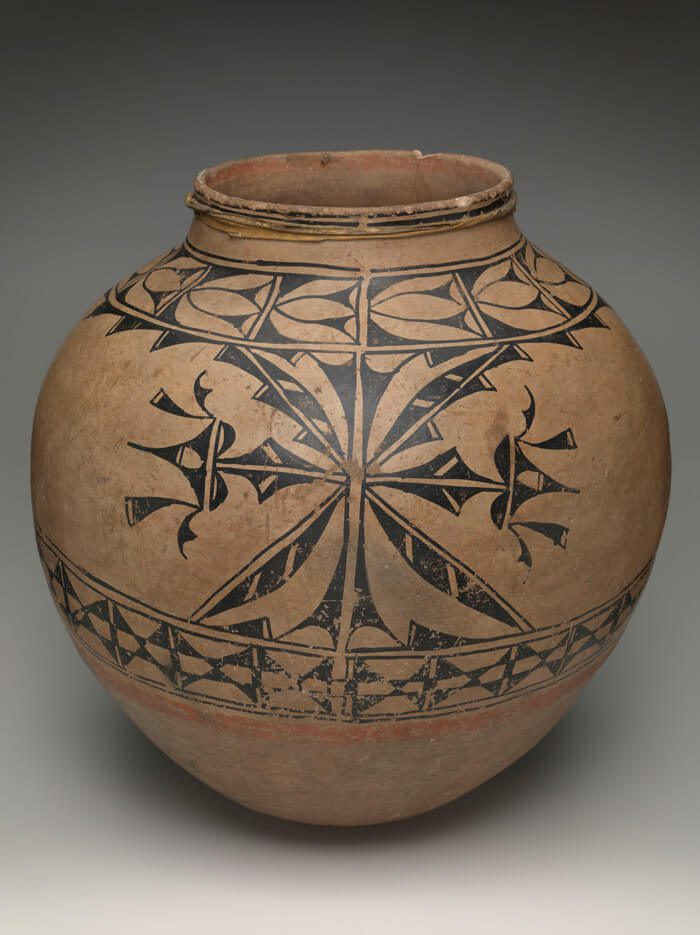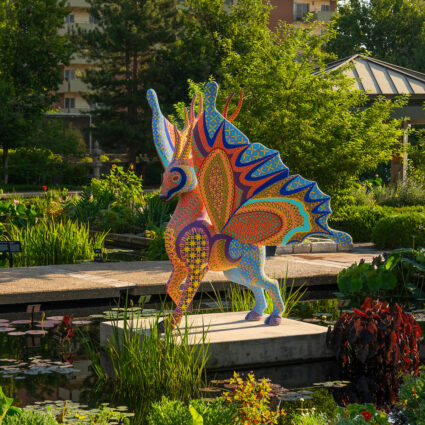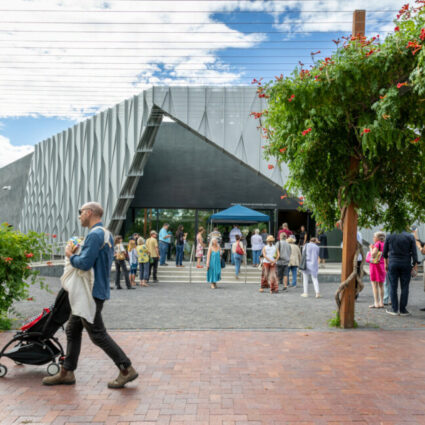
Di Wae Powa: They Came Back
October 12, 2019–continuous
Poeh Cultural Center, Pueblo of Pojoaque
“You are home now, Uvi Powa, you have arrived, Gi-hi-chung, we are happy, wia na-ing, ah-di uvi kwan, you are with us again.” —Tessie Naranjo (Santa Clara Pueblo), from exhibition panel text.
Simple lines guide the eye through display cases stacked with canteens and storage jars, with earth tones, fire clouds, and polychrome designs vivid on their stepped pedestals. Di Wae Powa: They Came Back, an exhibition which opened in the fall of 2019 at the Poeh Cultural Center, in partnership with the Smithsonian Institution’s National Museum of the American Indian (NMAI), is a step towards reconciling a muddy and violent history of colonialism in the Southwest.
Throughout the late 1800s and early 1900s, anthropologists—largely white, male, and funded by East Coast institutions—traversed New Mexico collecting belongings from what was thought to be “the vanishing Indian.” The items they took are not lifeless objects, but instead living extensions of one’s self, family, and community. Today, museums operate as vestiges of this imperialist project, but some, more and more of which are led by Native people, are looking to confront these harmful legacies. It’s a movement driven by Indigenous activists, scholars, and community members who are adamantly working to bring their relatives home.
In 2015, then-Lieutenant Governor of the Pueblo of Pojoaque Joseph Talachy (Pueblo of Pojoaque) and Pojoaque’s tribal historic preservation officer, Dr. Bruce Bernstein, approached NMAI about bringing a large collection of Tewa items back to the Rio Grande Valley. After much work from both institutions, one hundred pots have returned home.
When Lynda Romero (Pueblo of Pojoaque), collections manager at the Poeh, first visited NMAI, she realized “what the pots meant to me, how they helped me reconnect with my Pueblo, and then realized the possibilities of what bringing them back would mean.” Dr. Cynthia Chavez Lamar (San Felipe Pueblo/Hopi/Tewa/Navajo), assistant director for collections at NMAI, agrees. “NMAI endeavors to work collaboratively and in partnership with tribal institutions like the Poeh Cultural Center. It is through these partnerships that we are able to see the benefits of these pots being back in the vicinity of their ancestral homelands and people.”
The pieces themselves are spectacular—from pitchers to dough bowls, each evokes intimate stories of creation, use, collection, and return.
Before you enter Di Wae Powa, you are greeted by Tessie Naranjo (Santa Clara Pueblo), who speaks to both the pots and the visitor, asking for them to be in relationship with one another. The simplicity and poignancy of the exhibition’s design is striking. Pots are installed on earth-toned terraced steps, shadowing the display and use of pottery within the Pueblo home.
The pieces themselves are spectacular—from pitchers to dough bowls, each evokes intimate stories of creation, use, collection, and return. Items are not accompanied by lifeless institutional data such as artist, date, medium, size, or community of origin. Instead, visitors are gently asked to look closely, to follow the path of each artist’s brushstroke, of each Smithsonian curator’s catalog number. By experiencing an exhibition in this way, we can then begin to think through each piece’s potential physical and temporal trajectories.

The Poeh Center, though based in and run by the Pueblo of Pojoaque, is a cultural center serving Tewa communities—Nambé, Ohkay Owingeh (formally San Juan), Tesuque, San Ildefonso, Pojoaque, and Santa Clara—as a whole. An exhibition primarily organized by and for Pueblo people, They Came Back is a research space and teaching collection, where contemporary potters connect with their ancestors, learning from the works of their family.
“It’s so important for the collections to come back to our community, to come back to us. It’s a good feeling. I’m just so happy they’re here,” reflects Romero.
The Poeh Center’s Di Wae Powa bravely challenges what museums are and can be. How can tribally controlled cultural centers and museums reframe conversations around contemporary Indigeneity? As temporary stewards of Native items, how can Western museums better collaborate with communities? What does the future of the museum look like? Indeed, the Poeh Center and NMAI have set a new standard for co-stewardship, where institutional histories are confronted and community desires take center stage.



